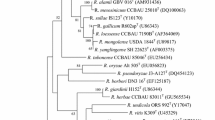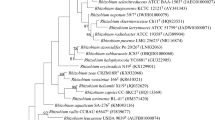Abstract
One Gram-negative, aerobic, motile, rod-shaped bacterium, designated as FH14T, was isolated from nodules of Phaseolus vulgaris grown in Hidalgo State of Mexico. Results based upon 16S rRNA gene (≥99.8 % similarities to known species), concatenated sequence (recA, atpD and glnII) analysis of three housekeeping genes (≤93.4 % similarities to known species) and average nucleotide identity (ANI) values of genome sequence (ranged from 87.6 to 90.0 % to related species) indicated the distinct position of strain FH14T within the genus Rhizobium. In analyses of symbiotic genes, only nitrogen fixation gene nifH was amplified that had nucleotide sequence identical to those of the bean-nodulating strains in R. phaseoli and R. vallis, while nodulation gene nodC gene was not amplified. The failure of nodulation to its original host P. vulgaris and other legumes evidenced the loss of its nodulation capability. Strain FH14T contained summed feature 8 (C18:1 ω6c/C18:1 ω7c, 59.96 %), C16:0 (10.6 %) and summed feature 2 (C12:0 aldehyde/unknown 10.928, 10.24 %) as the major components of cellular fatty acids. Failure to utilize alaninamide, and utilizing l-alanine, l-asparagine and γ-amino butyric acid as carbon source, distinguished the strain FH14T from the type strains for the related species. The genome size and DNA G+C content of FH14T were 6.94 Mbp and 60.8 mol %, respectively. Based on those results, a novel specie in Rhizobium, named Rhizobium hidalgonense sp. nov., was proposed, with FH14T (=HAMBI 3636T = LMG 29288T) as the type strain.

Similar content being viewed by others
References
Anyango B, Wilson KJ, Beynon JL et al (1995) Diversity of rhizobia nodulating Phaseolus vulgalis L. in 2 Kenyan soils with contrasting pHs. Appl Environ Microbiol 61:4016–4021
Aserse AA, Rasanen LA, Assefa F et al (2012) Phylogeny and genetic diversity of native rhizobia nodulating common bean (Phaseolus vulgaris L.) in Ethiopia. Syst Appl Microbiol 35:120–131. doi:10.1016/j.syapm.2011.11.005
Cowan ST, Steel KJ (1996) Manual for the identification of medical bacteria. Cambridge University Press, London
Dall’Agnol RF, Ribeiro RA, Ormeno-Orrillo E et al (2013) Rhizobium freirei sp. nov., a symbiont of Phaseolus vulgaris that is very effective at fixing nitrogen. Int J Syst Evol Microbiol 63:4167–4173. doi:10.1099/ijs.0.052928-0
Delcher AL, Bratke KA, Powers EC et al (2007) Identifying bacterial genes and endosymbiont DNA with Glimmer. Bioinformatics 23:673–679. doi:10.1093/bioinformatics/btm009
Hall TA (1999) BioEdit: a user-friendly biological sequence alignment program for Windows 95/98/NT. Nucleic Acids Symp Ser 41:95–98
Jiao YS, Yan H, Ji ZJ et al (2015) Rhizobium sophorae sp. nov. and Rhizobium sophoriradicis sp. nov., nitrogen-fixing rhizobial symbionts of the medicinal legume Sophora flavescens. Int J Syst Evol Microbiol 65:497–503. doi:10.1099/ijs.0.068916-0
Jimenez G, Urdiain M, Cifuentes A et al (2013) Description of Bacillus toyonensis sp. nov., a novel species of the Bacillus cereus group, and pairwise genome comparisons of the species of the group by means of ANI calculations. Syst Appl Microbiol 36:383–391. doi:10.1016/j.syapm.2013.04.008
Kumar N, Lad G, Giuntini E et al (2015) Bacterial genospecies that are not ecologically coherent: population genomics of Rhizobium leguminosarum. Open Biol 5:140133
Lagesen K, Hallin P, Rodland EA et al (2007) RNAmmer: consistent and rapid annotation of ribosomal RNA genes. Nucleic Acids Res 35:3100–3108. doi:10.1093/nar/gkm160
Laguerre G, Nour SM, Macheret V et al (2001) Classification of rhizobia based on nodC and nifH gene analysis reveals a close phylogenetic relationship among Phaseolus vulgaris symbionts. Microbiology-Uk 147:981–993. doi:10.1099/00221287-147-4-981
Lopez-Lopez A, Rogel-Hernandez MA, Barois I et al (2012) Rhizobium grahamii sp. nov., from nodules of Dalea leporina, Leucaena leucocephala and Clitoria ternatea, and Rhizobium mesoamericanum sp. nov., from nodules of Phaseolus vulgaris, siratro, cowpea and Mimosa pudica. Int J Syst Evol Microbiol 62:2264–2271. doi:10.1099/ijs.0.033555-0
Lowe TM, Eddy SR (1997) tRNAscan-SE: a program for improved detection of transfer RNA genes in genomic sequence. Nucl Acids Res 25:955–964. doi:10.1093/nar/25.5.955
Luis Zurdo-Pineiro J, Garcia-Fraile P, Rivas R et al (2009) Rhizobia from Lanzarote, the Canary islands, that nodulate Phaseolus vulgaris have characteristics in common with Sinorhizobium meliloti isolates from mainland Spain. Appl Environ Microbiol 75:2354–2359. doi:10.1128/aem.02811-08
Luo R, Liu B, Xie Y et al (2012) SOAPdenovo2: an empirically improved memory-efficient short-read de novo assembler. Gigascience 1:18. doi:10.1186/2047-217x-1-18 (Errutum in Gigascience 2015)
Martens M, Dawyndt P, Coopman R et al (2008) Advantages of multilocus sequence analysis for taxonomic studies: a case study using 10 housekeeping genes in the genus Ensifer (including former Sinorhizobium). Int J Syst Evol Microbiol 58:200–214. doi:10.1099/ijs.0.65392-0
Martinez Romero E (2003) Diversity of Rhizobium Phaseolus vulgaris symbiosis: overview and perspectives. Plant Soil 252:11–23. doi:10.1023/a:1024199013926
Mhamdi R, Laguerre G, Aouani ME et al (2002) Different species and symbiotic genotypes of field rhizobia can nodulate Phaseolus vulgaris in Tunisian soils. FEMS Microbiol Ecol 41:77–84. doi:10.1111/j.1574-6941.2002.tb00968.x
Mnasri B, Aouani ME, Mhamdi R (2007) Nodulation and growth of common bean (Phaseolus vulgaris) under water deficiency. Soil Biol Biochem 39:1744–1750. doi:10.1016/j.soilbio.2007.01.030
Mnasri B, Liu TY, Saidi S et al (2014) Rhizobium azibense sp. nov., a nitrogen fixing bacterium isolated from root nodules of Phaseolus vulgaris. Int J Syst Evol Microbiol 64:1501–1506. doi:10.1099/ijs.0.058651-0
Mousavi SA, Willems A, Nesme X et al (2015) Revised phylogeny of Rhizobiaceae: proposal of the delineation of Pararhizobium gen. nov., and 13 new species combinations. Syst Appl Microbiol 38:84–90. doi:10.1016/j.syapm.2014.12.003
Peng GX, Yuan QH, Li HX et al (2008) Rhizobium oryzae sp. nov., isolated from the wild rice Oryza alta. Int J Syst Evol Microbiol 58:2158–2163. doi:10.1099/ijs.0.65632-0
Ramirez Bahena MH, Garcia Fraile P, Peix A et al (2008) Revision of the taxonomic status of the species Rhizobium leguminosarum (Frank 1879) Frank 1889 (AL), Rhizobium phaseoli Dangeard 1926 (AL) and Rhizobium trifolii Dangeard 1926 AL. R. trifolii is a later synonym of R. leguminosarum. Reclassification of the strain R. leguminosarum DSM 30132 (=NCIMB 11478) as Rhizobium pisi sp. nov. Int J Syst Evol Microbiol 58:2484–2490. doi:10.1099/ijs.0.65621-0
Ribeiro RA, Rogel MA, Lopez-Lopez A et al (2012) Reclassification of Rhizobium tropici type A strains as Rhizobium leucaenae sp. nov. Int J Syst Evol Microbiol 62:1179–1184. doi:10.1099/ijs.0.032912-0
Ribeiro RA, Martins TB, Ormeno-Orrillo E et al (2015) Rhizobium ecuadorense sp. nov., an indigenous N2-fixing symbiont of the Ecuadorian common bean (Phaseolus vulgaris L.) genetic pool. Int J Syst Evol Microbiol 65:3162–3169. doi:10.1099/ijsem.0.000392
Richter M, Rossello-Mora R (2009) Shifting the genomic gold standard for the prokaryotic species definition. Proc Natl Acad Sci U S A 106:19126–19131. doi:10.1073/pnas.0906412106
Román-Ponce B, Zhang JY, Vásquez-Murrieta MS et al (2016) Rhizobium acidisoli sp. nov., isolated from root nodules of Phaseolus vulgaris in acid soils. Int J Syst Evol Microbiol 66:398–406. doi:10.1099/ijsem.0.000732
Sarita S, Sharma PK, Priefer UB et al (2005) Direct amplification of rhizobial nodC sequences from soil total DNA and comparison to nodC diversity of root nodule isolates. FEMS Microbiol Ecol 54:1–11. doi:10.1016/j.femsec.2005.02.015
Sasser M (1990) Identification of bacteria by gas chromatography of cellular fatty acids. Technical note 101
Saw JHW, Schatz M, Brown MV et al (2013) Cultivation and complete genome sequencing of Gloeobacter kilaueensis sp. nov., from a Lava Cave in Kilauea Caldera, Hawaii. PLoS One. doi:10.1371/journal.pone.0076376
Talbi C, Delgado MJ, Girard L et al (2010) Burkholderia phymatum strains capable of nodulating Phaseolus vulgaris are present in Moroccan soils. Appl Environ Microbiol 76:4587–4591. doi:10.1128/aem.02886-09
Tamura K, Peterson D, Peterson N et al (2011) MEGA5: molecular evolutionary genetics analysis using maximum likelihood, evolutionary distance, and maximum parsimony methods. Mol Biol Evol 28:2731–2739. doi:10.1093/molbev/msr121
Terefework Z, Kaijalainen S, Lindstrom K (2001) AFLP fingerprinting as a tool to study the genetic diversity of Rhizobium galegae isolated from Galega orientalis and Galega officinalis. J Biotechnol 91:169–180. doi:10.1016/s0168-1656(01)00338-8
Tian CF, Wang ET, Wu LJ et al (2008) Rhizobium fabae sp. nov., a bacterium that nodulates Vicia faba. Int J Syst Evol Microbiol 58:2871–2875. doi:10.1099/ijs.0.2008/000703-0
Tighe SW, de Lajudie P, Dipietro K et al (2000) Analysis of cellular fatty acids and phenotypic relationships of Agrobacterium, Bradyrhizobium, Mesorhizobium, Rhizobium and Sinorhizobium species using the Sherlock Microbial Identification System. Int J Syst Evol Microbiol 50:787–801. doi:10.1099/00207713-50-2-787
Tindall BJ, Rossello-Mora R, Busse HJ et al (2010) Notes on the characterization of prokaryote strains for taxonomic purposes. Int J Syst Evol Microbiol 60:249–266. doi:10.1099/ijs.0.016949-0
Toledo I, Lloret L, Martinez-Romero E (2003) Sinorhizobium americanus sp. nov., a new Sinorhizobium species nodulating native Acacia spp. in Mexico. Syst Appl Microbiol 26:54–64. doi:10.1078/072320203322337317
Verástegui-Valdés MM, Zhang YJ, Rivera-Orduña FN et al (2014) Microsymbionts of Phaseolus vulgaris in acid and alkaline soils of Mexico. Syst Appl Microbiol 37:605–612. doi:10.1016/j.syapm.2014.08.005
Vincent J (1970) A manual for the practical study of the root-nodule bacteria. International Biological Program, Blackwell Scientific, Oxford
Vinuesa P, Silva C, Lorite MJ et al (2005) Molecular systematics of rhizobia based on maximum likelihood and Bayesian phylogenies inferred from rrs, atpD, recA and nifH sequences, and their use in the classification of Sesbania microsymbionts from Venezuelan wetlands. Syst Appl Microbiol 28:702–716. doi:10.1016/j.syapm.2005.05.007
Weisburg WG, Barns SM, Pelletier DA et al (1991) 16S ribosomal DNA amplification for phylogenetic study. J Bacteriol 173:697–703
Zhang YM, Tian CF, Sui XH et al (2012) Robust markers reflecting phylogeny and taxonomy of rhizobia. PLoS One. doi:10.1371/journal.pone.0044936
Acknowledgments
This study was financially supported by the National Natural Science Foundation of China (41371296). ETW was supported by the projects SIP20150597 authorized by Instituto Politecnico Nacional, México.
Author information
Authors and Affiliations
Corresponding authors
Additional information
Communicated by Erko Stackebrandt.
Electronic supplementary material
Below is the link to the electronic supplementary material.
Rights and permissions
About this article
Cite this article
Yan, J., Yan, H., Liu, L.X. et al. Rhizobium hidalgonense sp. nov., a nodule endophytic bacterium of Phaseolus vulgaris in acid soil. Arch Microbiol 199, 97–104 (2017). https://doi.org/10.1007/s00203-016-1281-x
Received:
Revised:
Accepted:
Published:
Issue Date:
DOI: https://doi.org/10.1007/s00203-016-1281-x




